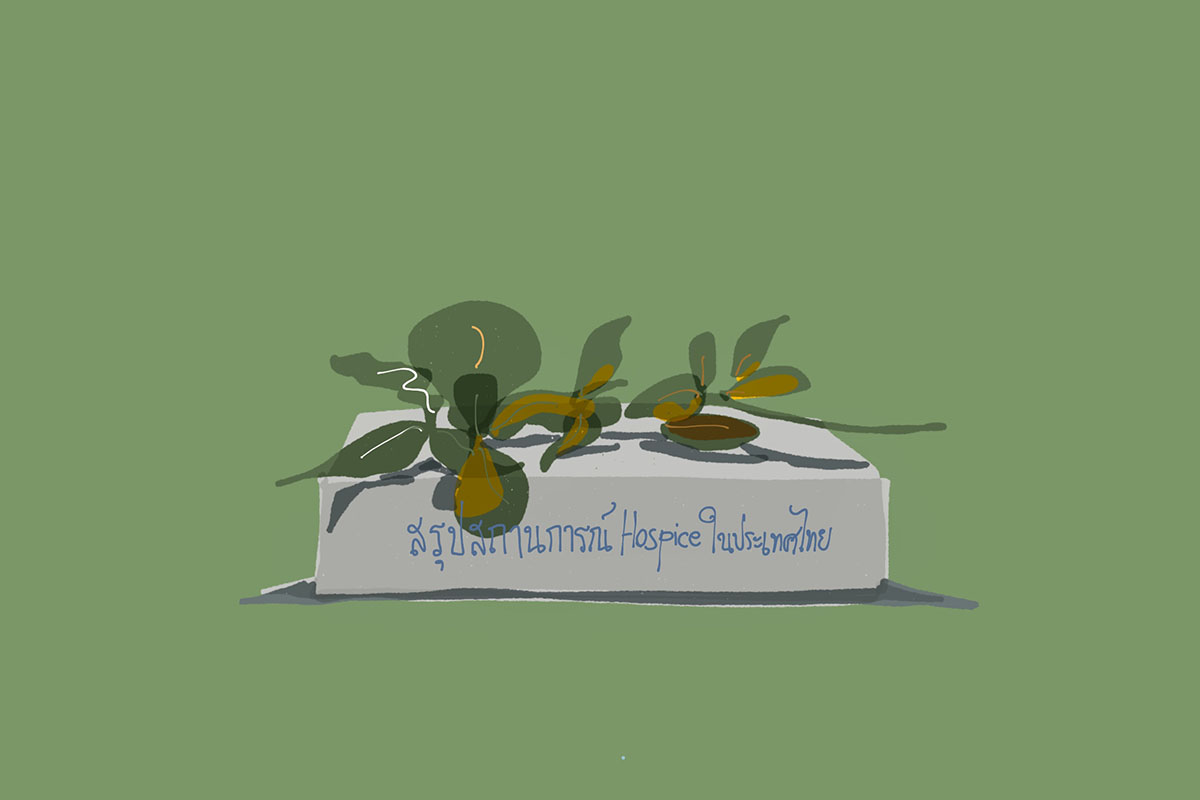Story: Sarinthorn Ratjaroenkhajorn
Palliative care, a framework of caregiving that is making rapid progress in healthcare institutions and communities across the country, can raise the quality of life of many severely ill patients. Though if we look around ourselves, aren’t there certain groups of patients that are still neglected. They may become seriously ill and ultimately die alone… on the other side of the wall.
Palliative care is becoming more important in the public health landscape; it was reified in the National Strategic Plan For Enhancing End of Life Well-being (2013-2016). In 2015, the government issued a decree for all hospitals (hospital centres, general hospitals and community hospitals) across the country to establish a palliative care unit. Currently, the majority of hospitals (over 90%) do offer palliative care services, in addition to improving their palliative care knowledge and skill set with the intention of caring for every aspect terminally-ill patients’ quality of life. Their end-of-life care encompasses physical, mental, social and spiritual well-being, ensuring that patients pass away in peace and dignity — as human beings.
Therefore, patients do have access to palliative care services and a good quality of life at the end of their lives. However, there is a group of patients that has been forgotten, simply because they have made some mistakes in life. Living behind iron bars and barbed wire, they are our incarcerated population. Naturally, they also get sick, and within our prisons, there are undoubtedly people who are terminally-ill. They deserve to receive palliative care as well.

The Correctional Hospital is a prison that performs a unique duty. That is, it confines and provides treatment to incarcerated people who are sick. The hospital is located at Lat Yao prison, Bangkok (Khlong Prem Prison). When incarcerated individuals fall sick, they usually receive treatment at the healthcare centre at their facility. When a case exceeds the capacities of the healthcare centre, the patient is either sent to a hospital outside the correctional system or to the Correctional Hospital.
Currently, the Correctional Hospital has a 500-patient capacity and is divided into different departments: the outpatient department, dental clinic, and the inpatient ward, which is split into the psychiatric ward, surgery ward, internal medicine ward, tuberculosis ward and HIV ward. There are around 20 doctors in total (an approximate number, since there is a rotation of interns that come through the hospital), 120 nurses, and additional helpers, who are incarcerated individuals that have been trained in patient care, and attend to the patients.
“Palliative care is new to the Correctional Hospital,” reflects Tiparpa Yeunyang, a nurse practitioner at the hospital. “We began offering it 2-3 years ago, starting with chronically-ill patients with conditions that couldn’t be cured. We tried to look after them holistically, but there needs to be a system in place, and nurses need to be trained. So the hospital began sending its nurses for further training in palliative care”. Tiparpa had previously nursed cancer patients, and had therefore encountered terminally-ill patients before. Transferring to the Correctional Hospital, and seeing certain patients die alone, roused her interest in palliative care. She sees it as delicate work that takes time and comes from the heart: “it’s not just a matter of prescribing medication. After the medication we must evaluate its effect not only on the patient’s physical health, but in other areas too, because some things aren’t treated with medicine, but with conversation.”
At the moment, the Correctional Hospital is in the early stage of developing its palliative care services, and therefore does not yet employ any doctors specialised in palliative care nor have a ward dedicated to terminally-ill patients. However, the hospital continues its efforts to ensure that incarcerated, terminally-ill individuals have a good quality of life and pass away peacefully.
Their first task is pain management for cancer patients, which has proven to be extremely difficult. Since the morphine is classified as a category 2 narcotic, the hospital has to carefully monitor its use. The prescription of morphine requires expertise in assessing the appropriate dosage and treating side-effects. The hospital has solved this problem by partnering with the Cancer Foundation, which sends experts from the Pain Clinic to make rounds at the hospital once a week. The partnership has helped incarcerated patients receive morphine through the appropriate form of patches, oral capsules and injection, which mitigates patients’ suffering from pain. Moreover, the hospital is trying to look after their patients’ emotional well-being through a variety of different formats such as inviting monks to receive alms from patients at the beginning of every month, with the content of the patients’ alms supplied by the department of social work and various charities. Once the alms have been placed in the alms bowl, the monks return them for the patients to use.
Another activity which has had a tangible spiritual impact for patients is family visits. Originally, relatives were allowed only a 5-10 minute bedside visit. Nowadays, relatives can visit seriously-ill and terminally-ill patients for a half hour to an hour each time. Of course, patients want their families to be with them all the time, but this is not something the Correctional Hospital can do, and it has the duration of visiting time instead. Furthermore, 1 out of 3 of incarcerated, terminally-ill individuals are considered for compassionate release — that is, they will be allowed to live at home for the remainder of their lives.
In the event that an incarcerated individual passes away, the nurses are required to notify relatives and the forensic department. Though the hospital police know that the patient succumbed to their disease, an autopsy has to be performed on the body, and the cause of death formally determined, because they were incarcerated. Neither the nurses or helpers are allowed to move or even touch the body. Everyone has to wait for the forensic team to examine and remove the body. That being said, what nurses can do, and consider part of their practice of care, is to follow the tradition of asking for forgiveness for the deceased and place flowers around the body. The nurses tell the deceased that they have done their best to take care of them and to forgive them if they were remiss; they pray that the deceased has departed to a good place.

In the beginning, working in palliative care at the Correctional Hospital often entails facing no small number of obstacles. A significant limitation for caregivers are the various laws and regulations that need reviewing. For example: “the granting of compassionate release for terminally-ill patients, so that patients get to pass away at home. I want patients who receive a terminal diagnosis to be able to go home. But it’s difficult because we have to look at the regulations/laws to see what is preventing that from happening”.
Another issue is with the disorganization of the information network, as there are still obstacles to the coordination between different institutions in the community that the patient returns to, whether that is the patient’s former prison, or the the local healthcare centre at the patient’s home (in the event that the patient is released), in order to monitor the patient’s symptoms with continuity. There is also the problem of a shortage of necessary equipment for terminally-ill patients, such as air mattresses for bedridden patients, to give one example.
Another obstacle is the lack of knowledgeable palliative care doctors at the Correctional Hospital that would be able to treat patients and further develop its palliative care services. On the same note, the nurses, as colleagues in the same field, should have an understanding of palliative care as well, so that they can appropriately provide a good quality of life and a peaceful death for incarcerated patients just like all other patients. Regardless, the Correctional Hospital finds itself constantly presented with this question about inmate care: “They’ve committed crimes, so why look after them”? To this, Tiparpa responds: “But for me, they come to me sick, and I must take care of them. I don’t look at what they’ve done”. And it’s exactly like she says — she isn’t interested in the fact that the being in front of her is an incarcerated individual, but that they are a patient that needs to be fully cared for. She remembers one foreign incarcerated patient who was an atheist, but asked to touch a statue of the buddha before they took their last breath. When asked what the patient was serving time for, Tiparpa thought for a long time, but ultimately didn’t have an answer. She genuinely didn’t know what it was.
People who have done wrong, who have been convicted, and incarcerated are like everyone else that suffers from illness and death. The commitment to making sure that patients have a good quality of life at the end of their lives should be extended to all people from all walks of life, with not even one exception.
Citations:
Thiparpa Yeunyang, nurse practitioner at the Correctional Hospital, interviewed on 9/10/2018.
The Correctional Hospital’s website, https://www.hosdoc.com/index.php. Accessed on 26/10/2018.
Photo credit: https://unsplash.com/photos/G_gOhJeCpMg?utm_source=unsplash&utm_medium=referral&utm_content=creditCopyText



